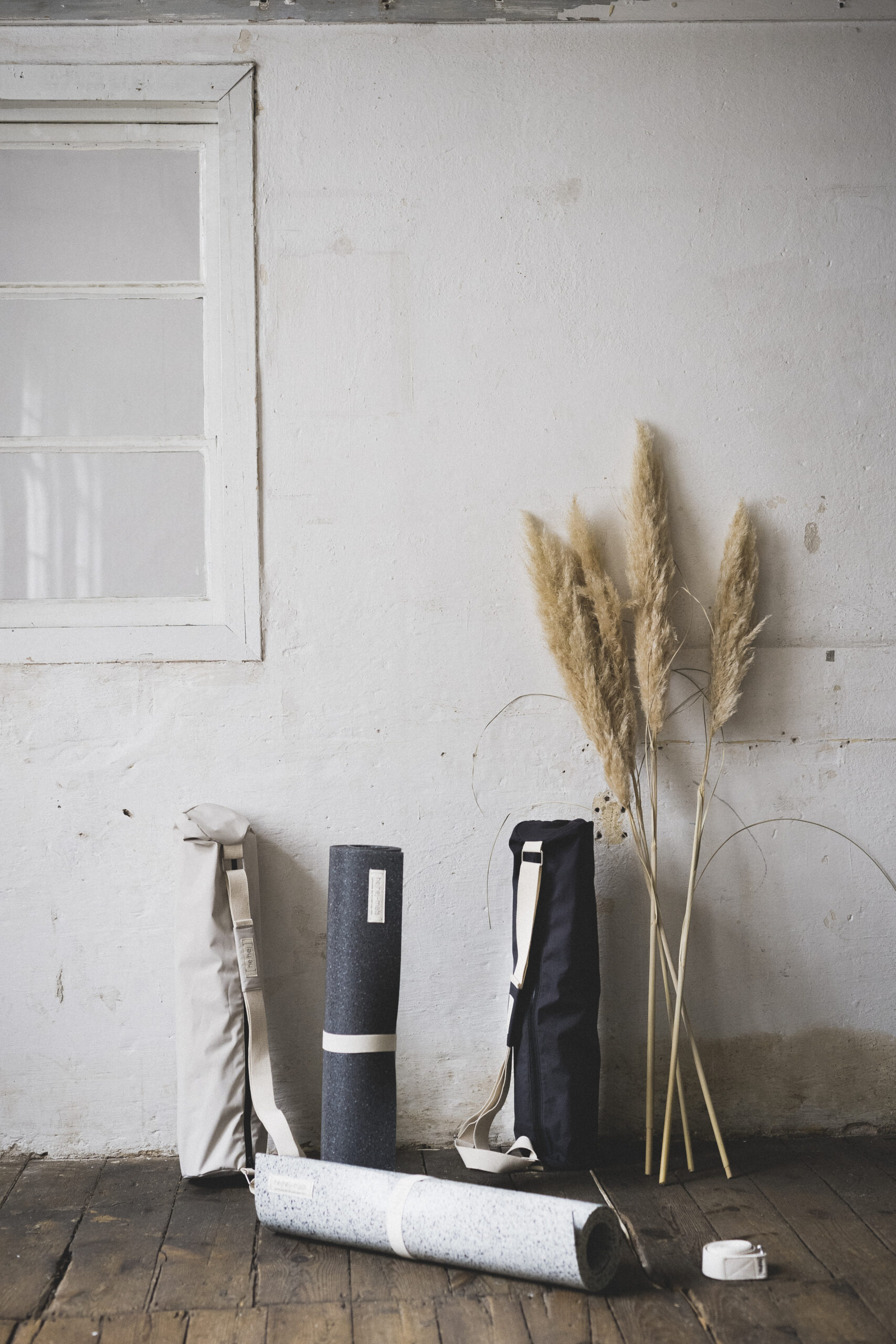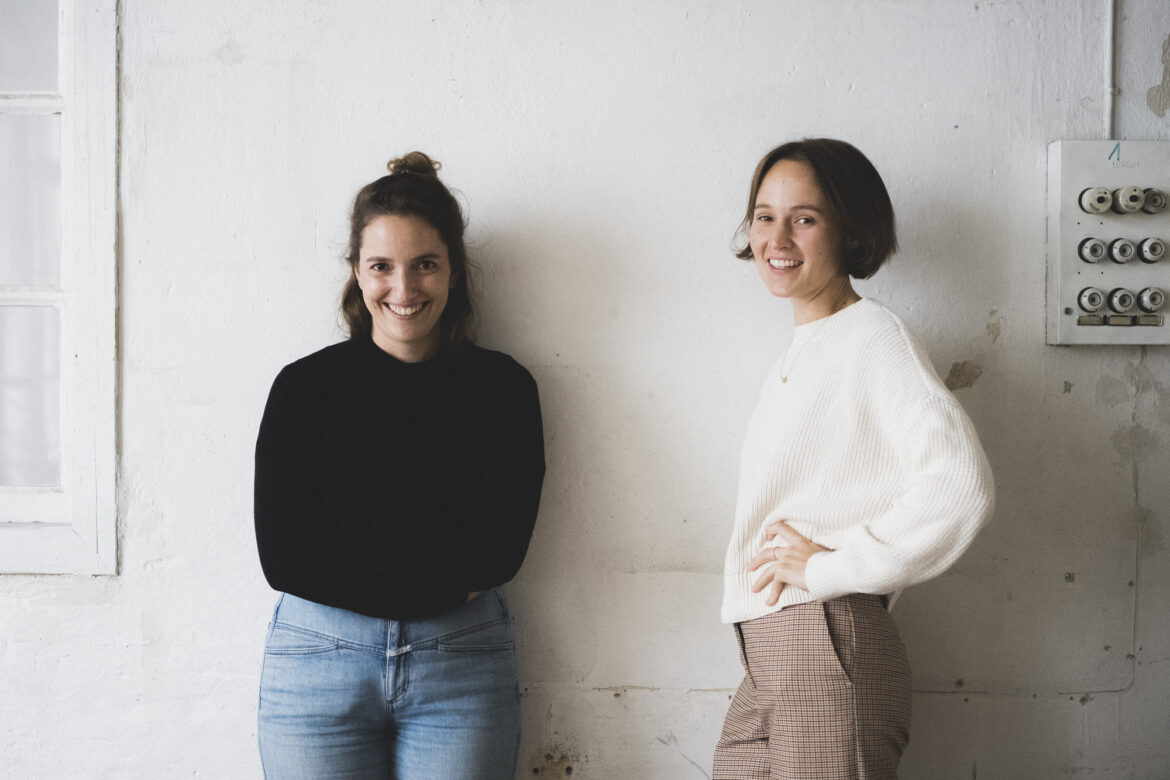In 2017 Anna Souvignier and Sophie Zepnik, then-students at Malmö University, founded hejhej. Starting out by selling recycled and closed-loop yoga mats, the company now sells a range of circular yoga products. We have talked to one of hejhej’s members, Pia, about the brand, what it stands for, and what it takes to found a sustainable business as a student at MAU.
Pike & Hurricane: Can you tell us a little bit about the background of hejhej? How did Anna and Sophie get the idea to found a business selling recycled yoga mats?
Pia: When Anna and Sophie got the idea, they were studying the master’s programme Leadership for Sustainability at Malmö University. While the nature of the programme made them consider sustainability issues all the time, it was an art exhibition in Gothenburg that gave them the actual idea for hejhej. There was one piece by an artist called Pinar Yoldas that was calling out the hypocrisy of yogis: On the one hand they very much embrace the respect for the people and environment around them but at the same time they practice with equipment that is made out of plastic. And Anna and Sophie felt like they were caught red-handed. And they absolutely agreed with the artist. They were practicing yoga without even thinking about the implications of what kind of material they used. So after the exhibition they kept thinking about the issue. They never really considered the option to found a business before, so in their case the whole foundation process was very intrinsic. They departed from this problem that really spoke to them and then weighed their options: What can we do, what do we want to do? That’s how they came up with their very first product, the hejhej-mat. And when they thought about the product that they wanted to produce, and how they wanted to go about it, it was clear to them from the beginning that they wanted to reach for the highest sustainability standard, which is the closed-loop approach, the circular approach. They would never create a product that does not fulfill these sustainability criteria.
P&H: So they created a business because there was a need for it rather than because they wanted to merely supply something?
P: Exactly. hejhej follows something called the “sufficiency strategy”, which means that they openly communicate: “Do not buy our product if you don’t need it.” It’s a major part of their communication and their beliefs that you should only buy if you need it and that you ask informed questions about where and how something is produced. For their second crowdfunding campaign, they launched a video that started with: “If you already have a bag for your yoga mat, then this video isn’t for you.” That’s a pretty bold statement and they felt that this was something very courageous––of course they need people to buy their products. But they 100% believe in the sufficiency strategy and that they only want people to buy when they need it. Because that’s part of the highest standard of sustainability, that you consume when you need to, not for the fun of it.
P&H: hejhej advertises their products as being 100% recyclable. How about the resources that are used in the production? Are those 100% recycled, too?
P: Most of the material that we use is already recycled, yes. And as you said we only use material that is recyclable. Otherwise that wouldn’t meet the closed-loop criteria, if we couldn’t take back the products at the end of their lifespan and recycle them. So every product is designed to be sent back to us and be recycled.
The biggest part of the mat is the foam and that is made from recycled foam off-cuts that we get from other productions, like mattress productions for example. So it is actually waste for others but we turn this waste into a new resource and turn it into the hejhej-mat. There is a textile between the foam layers that is keeping the mat together and making it tear-proof and very durable. In the beginning it was not recycled, but a few months ago we finally developed this layer to be made of a recycled material. Often it is also a very long process for us to talk to our producers, develop new ways of doing things, or producing these materials. The one part of the hejhej-mat that is not made from recycled material is the top layer, because that needs to be medically confirmed. So there is a very thin layer on top that is made from a virgin material. We would love to also use recycled material there too it is just not existing yet. Once we recycle the mat though, we can use all of the material again––including the top layer.

The bag is made of recycled PET bottles and the zipper is made from recycled fishing nets. The strap of the bag, which is also the yoga belt, is made from hemp. This material is chosen very consciously because it uses much less water than other alternatives like cotton for example. But we actually have to import this from Asia, just because there is so little hemp being cultivated in Europe. This is the only material that we import from afar, all the other materials are from Germany or neighbouring countries, like Austria, Switzerland,France, and Italy.
The outer layer of the bolster is made from a mix of material: cotton, recycled cotton, and hemp. With these, as with all materials, we always opt for the organic version. We also, if possible, try to go for recycled materials or at least a mixture. What is also cool about the bolster is that it is filled with the husks of spelt grains. It can be given to animals as a supplement to their food or as a natural fertilizer for soil, but in the end it is mostly considered as waste product by the industry. But we can use this perfectly as a filling for our bolster instead of using a virgin material. So what we always try to do is to use material that either exists in abundance or is considered waste by other producers.
P&H: “Sustainability” is such a catch phrase these days––it’s the red thread in every major company’s responsibility report, even those whose nature is wholly unsustainable. As a circular business that whole-heartedly believes in and promotes sustainability, how would you create more awareness around the problem of greenwashing?
P: Yes, many companies have started introducing what they call “circular products” or “sustainable fashion”. The problem is that there is no catalogue of criteria that a company needs to fulfill before they can call something sustainable. So even Primark offers “sustainable” jeans now, that still only cost 20€. At this price it is self-evident that there will be workers in the supply chain that are not paid fairly, and it is virtually impossible to uphold environmental standards in the production at such a low price. The same goes for closed-loop or circular products: There are big companies that are advertising circular denim––but they are not taking the products back. They are not closing the loop, which means it is not circular. They merely use recycled fabric, which in itself does not fulfill the circular standard. We sent them a message because we are always interested to see how other companies apply the concept and they replied: “Bring the product to your local denim recycling at the end of the lifespan.” There is no such thing as a local denim recycling!
We always have to remind ourselves that not everyone is familiar with the concept of a circular economy and we have to keep explaining a lot and try to be as transparent as possible about everything. So that includes being honest about our progress, for instance the top layer of the mat. Okay, the top layer isn’t made from recycled products yet but hey, we just found a way to use a recycled middle layer. We are not perfect but we are always aiming to become better, more sustainable and circular in every aspect. And most importantly we are transparent about it. People know exactly what material we are using, where we are producing, how we are producing, that we take products back and so on. And by that we want to motivate people to ask well-informed questions-–Where is it from? Do I need it? Who is involved?––when they are buying products elsewhere, too. So hopefully people will realise that when other companies advertise something as “sustainable” or “circular” that this might not actually be the case.
P&H: What role do sustainable startups play, in your eyes, when it comes to building a truly greener economy?
P: I would say that especially startups that are financially independent from investors and follow a strong vision––something which I have often experienced to be the case––are moving towards their goals in very determined and fast ways. Larger companies, where many more people, especially investors, are involved take longer to achieve these goals. Of course you can’t generalize this, but in my perception, there are so many startups with great visions, full of ideals, that are striving to change the way people think and consume for the better. They are really acting out of their ideals and their wish to change the economy. They are not only driven by their profit but by people and the planet. They are just always a great source of inspiration and they help create a climate in which well-informed customers ask the right questions. And that pressures larger and less-sustainable companies to change their approach.
P&H: Sustainability does not just include environmental aspects but also social dimensions. How does hejhej score in this area?
P: That’s definitely a very big and important part of hejhej’s business. For one, the company is donating a Euro for every product sold to a non-governmental organisation in Cape Town, South Africa, called “Earth Child Project”. The NGO is supporting children in difficult life situations, by enabling them to have weekly yoga classes and gardening classes. The aim is to teach the children resilience: How to listen to their bodies, take care of their bodies and minds. They support kids that already have faced a lot of struggle in their young lives. Through our donations over the years we have enabled 327 kids to participate in weekly yoga classes for a year, and 235 to attend the gardening classes.
Locally, parts of the production take place in workplaces for people with disabilities. So the yoga mat bag is produced there and they also take care of sewing the label on the mats, and they handle the shipping of products. So there is a team in the workplaces that is dedicated to working with hejhej. Sophie visits them approximately once a week to keep in touch, make sure the processes are clear, and include them in the bigger process. It is Sophie’s and Anna’s goal to one day employ a team of their own that can for instance handle the shipping and that hejhej can be an inclusive team, too. Of course, for now that is not possible because we all work remotely all over Germany and we don’t even have an office. But Sophie tries to still work very closely with them.
P&H: hejhej was founded with the help of Drivhuset Malmö, the startup hub for MAU students. How was the experience with Drivhuset?
P: Anna’s and Sophie’s experience was extremely good. They just took the idea to Drivhuset and they found it really helpful to get feedback, to have someone asking the right questions, to get input from people with entrepreneurial experience. They said that before it was just them and their friends talking about the idea and planning, and then through Drivhuset they had contact to experts that helped them develop and grow their idea. They also instructed them about the next steps, which is very important because in the beginning you have no idea about so many things that are awaiting you down the line. Drivhuset also connected them with external experts who could help them further down the line, and informed them about scholarships like Leapfrog, for which they applied and received funding. They really recommend Drivhuset and are very thankful for the experience. They would suggest to anyone with even just a vague idea to go there, make an appointment, and make use of this great opportunity. The Swedish spirit of founding is so different from the German one, for instance, so for them it really was a unique opportunity to start a business. Especially because that wasn’t on their agenda before.
P&H: What are some of hejhej’s favourite circular startups founded in Malmö?
P: Seljak Brand is definitely a startup that we’d recommend. They produce wool blankets made from wool offcuts. They are located in Tasmania, Australia, but Sammy, one of the co-founders, also studied at MAU. Anna and Sophe met her during their master’s. They have been a great inspiration for hejhej because Sammy had already founded the startup before starting her studies at MAU, so she gave some really helpful advice. Basically all the lessons that Sammy had learned, she passed on to Anna and Sophie so they could avoid those mistakes.
There is also Repamera, located in Malmö. They are founded by Henning (who is the founder of Circular Monday) and they are a shop that repairs clothes. A very cool circular startup!
P&H: Is there anything that has been left unsaid?
P: I have some advice from Sophie and Anna: They say that the most important thing when it comes to founding is to really trust in your idea. There will be a lot of obstacles––there is no way there won’t be––so that basic trust is absolutely necessary. Also, talk to other people! In the beginning, they were worried to talk to others, because they worried others might be stealing their idea. But there is so much to be learned from others and advice to be gained if you discuss your idea.
Check out their website here.
Related articles:
Circular Economy – Interview with the founders of “sveeka”
Photo credits:
hejhej founders Anna Souvignier and Sophie Zepnik. Photo Credits: Maria-Bayer
hejhej mats and straps. Photo Credits: Maria Bayer










